Brussels Vs Liège: What's The Difference Between These Belgian Waffles?
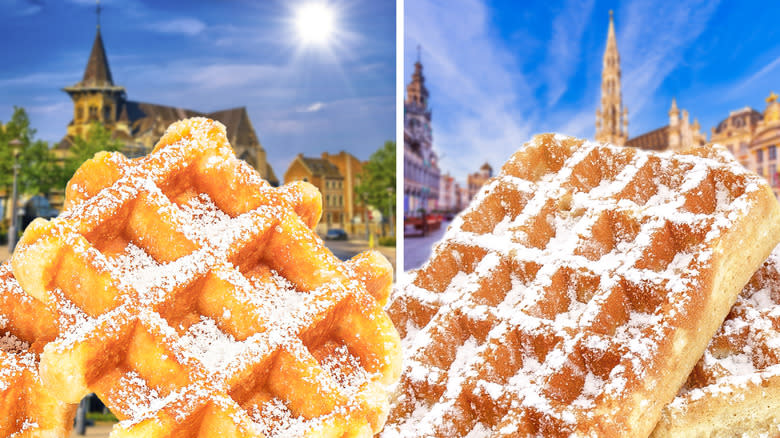
Not all waffles are created equal in Belgium, and the existence of Brussels and Liège waffles illustrates this fact. From taste, texture, and appearance, Brussels and Liège waffles have each cemented their identities, making their way into the bellies and hearts of Europeans and visitors alike.
If you find yourself roaming cities throughout the Western European country or have just happened upon a waffles-selling cart at your local farmers market, understanding the difference between the two can help make ordering easier. Since they're both delicious, actually choosing which doughy, crunchy vehicle with which to coat your preferred adornments — whether that's powdered sugar or fruit toppings — presents a challenge.
The recipes to make Brussels and Liège waffles differ, as does how these waffles are presented, but the biggest tip-off for which version you're about to sink your teeth into comes down to the shape of your iron-cooked treat.
Read more: 25 Best Ice Cream Brands Ranked
What Are Brussels Waffles?
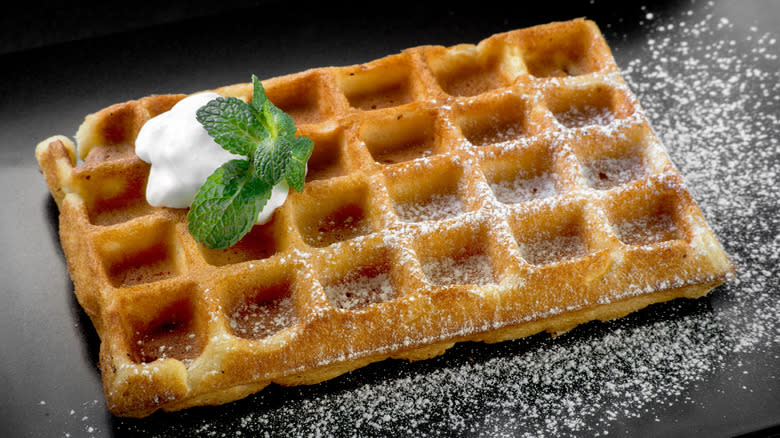
Brussels waffles are easy to identify by their shape. The square, Tetris-looking pieces offer straight edges to those ready to tuck into the treat. Though Brussels waffles originally displayed pockets in a 4 by 5 grid, Brussels waffles can also be served pressed with 15 or 24 indentations, set out in evenly-spaced designs.
These stamped divets of Brussels waffles are meant to serve as vessels for added toppings like fruits or syrups, and the recipe to make these them is light enough to complement sweeter additions of homemade whipped cream or pieces of chocolate. Made with yeast, flour, butter, eggs, vanilla, and milk, the batter to make Brussels waffles results in a crispy waffle that can be easily cut into. Ideally, chefs have access to waffle makers that can be flipped and rotated to ensure even cooking, and the ideal result is a golden, crispy waffle that is light and perfectly shaped.
What Are Liège Waffles?
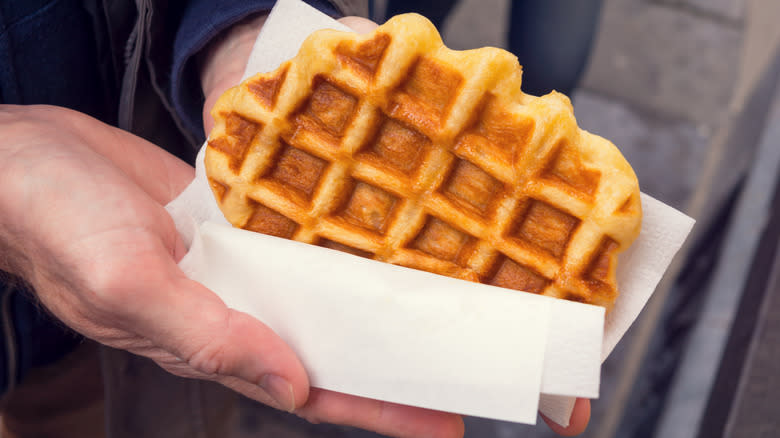
The name itself -- referred to as gaufre de Liège or gaufre Liègeoise in French -- is the first indication that Liège waffles offer a different tasting experience from Brussels waffles. Culinary rumors swirl that a Belgium cook for Liège's 18th-century prince came up with the recipe as a response to the royal's demands for something delicious and sweet. Indeed, Liège waffles offer a thicker, sweeter treat to bite into. More bready in taste, the batter to make Liège waffles is speckled with pearl sugar, resulting in a caramelized, sweet texture that is chewy and rich.
Unlike the liquid batter that forms Brussels waffles, the mixture to make Liège waffles is more doughy and dense. Flour, butter, yeast, eggs, milk, and pearl sugar combine to produce these thick, sweet, and soft treats. Liège waffles are often served as afternoon snacks in napkins that can be taken on the go, and these waffles don't include the various toppings that often adorn Brussels waffles. Plus, with irregular shapes that fail to adhere to the strict, lined edges that Brussels waffles present, the haphazard edges of the Leige waffles offer a more texturally interesting treat. Traditionally, these waffles will look more round when served, and the holes of the waffles usually are stamped with shallower wells in a 4 by 6 grid.
Differences In Appearance
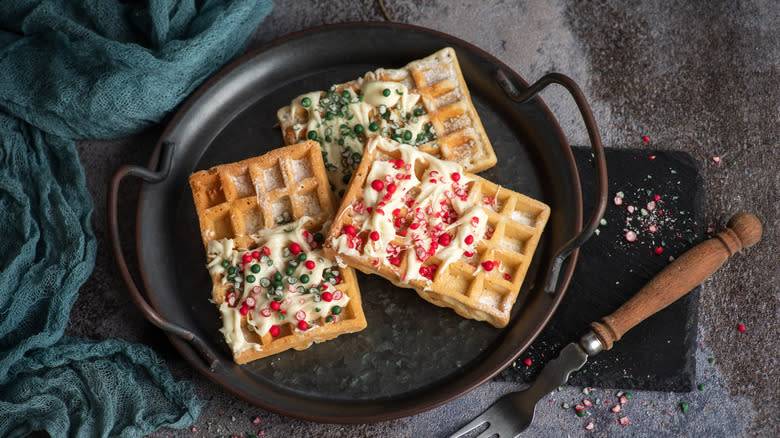
Not only are Liège waffles smaller than the Brussels variety, but these waffles are denser, thicker, and richer. This difference is primarily due to the caramelization that results from the addition of pearl sugar in the dough. The yeasty dough to make Liège waffles is said to have evolved from a similar recipe used to make brioche bread, which would account for its soft and chewy texture.
While Brussels waffles tend to offer a larger surface area to act as a platform for various sweet and fruity garnishes, Liège waffles are smaller by the order and more easily held or folded into paper. Think of the Brussels waffles as a light and crispy foundation for dessert that calls for the assistance of a fork and knife while the palm-sized Liège waffles are perfect for an afternoon snack or a late-morning boost of energy on the go.
Differences In Taste
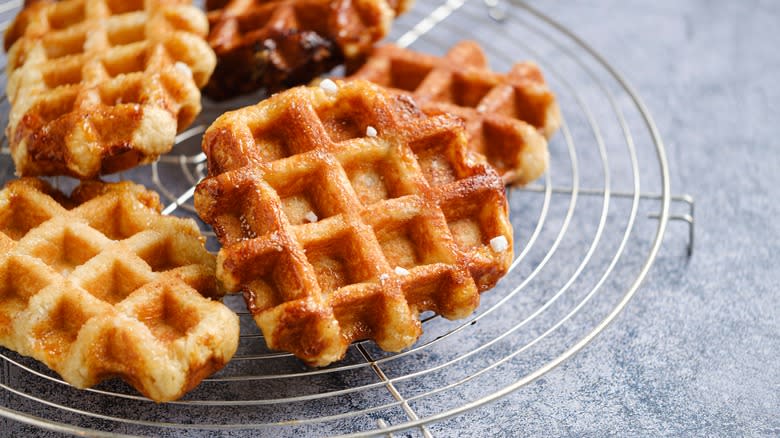
If you're looking to quell a demanding sweet tooth, the sugar-enhanced Liège waffle is at the ready. With a golden, crunchy exterior and a bready, chewy inside, Liège waffles are commonly flavored with cinnamon or vanilla or enhanced with sticks of chocolate or extra garnishes of pearl sugar or cocoa. Traditionally, Liège waffles are served plain, without the addition of toppings or fillings, but chefs commonly tweak recipes to meet the demands of palates eager for add-ons. While Brussels waffles have the potential of turning soggy when cold, Lèige waffles can be eaten cold or freshly made.
Though they offer a lighter, crispier texture to enjoy, Brussels waffles also contain subtle flavors of vanilla. While added vanilla and sprinkles of cinnamon can add a touch of sweetness to Brussels waffle recipes, these are generally less sweet than a Liège waffle. Better for those who prefer savory dishes, Brussels waffles are the variety that will most commonly be topped with meats and cheeses.
Read the original article on Tasting Table.

 Yahoo Finance
Yahoo Finance 